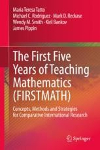- About MAA
- Membership
- MAA Publications
- Periodicals
- Blogs
- MAA Book Series
- MAA Press (an imprint of the AMS)
- MAA Notes
- MAA Reviews
- Mathematical Communication
- Information for Libraries
- Author Resources
- Advertise with MAA
- Meetings
- Competitions
- Programs
- Communities
- MAA Sections
- SIGMAA
- MAA Connect
- Students
- MAA Awards
- Awards Booklets
- Writing Awards
- Teaching Awards
- Service Awards
- Research Awards
- Lecture Awards
- Putnam Competition Individual and Team Winners
- D. E. Shaw Group AMC 8 Awards & Certificates
- Maryam Mirzakhani AMC 10 A Awards & Certificates
- Two Sigma AMC 10 B Awards & Certificates
- Jane Street AMC 12 A Awards & Certificates
- Akamai AMC 12 B Awards & Certificates
- High School Teachers
- News
You are here
The First Five Years of Teaching Mathematics (FIRSTMATH)

Publisher:
Springer
Publication Date:
2020
Number of Pages:
173
Format:
Hardcover
Price:
109.99
ISBN:
978-3-030-44046-6
Category:
Monograph
[Reviewed by , on ]
Mary Beth Rollick
04/5/2021
This book would be helpful to researchers who are interested in conducting research on mathematics teacher education. The focus of this book is on beginning mathematics teachers at the primary and secondary levels. The first five years of teaching are pivotal in determining whether teachers continue in the profession. More importantly, past studies have shown the integral part a teacher plays in shaping instruction and providing learning opportunities for the students. Because of this central position of the teacher, questions arise regarding the best mathematical and pedagogical preparation for teachers as well as the best practices for continued learning opportunities that should be offered to teachers.
One caveat is that this book is not a report of research to answer these best-practice questions for pre-service and in-service programs. This book describes a proof-of-concept study which is a study that develops and tests strategies on a small scale before conducting the large research project. The funding for this project was aimed at determining whether a cross-national study could be achieved with necessary rigor. Each chapter gives painstaking details about one aspect of the project design such as sampling procedures, validity framework for assessments, design of questionnaires and observation protocol. Included in these chapters is information about challenges faced and how the team overcame them to build a valid theoretical framework to guide a future study across international countries and cultures. An example of the many challenges cited in the book was that of developing a sampling process to identify beginning teachers. Thirteen countries agreed to work with the project but only twelve sent data. Some of the countries did not have good records about the number of years their teachers had been a formal teacher of record and then a time lag caused some beginning teachers to move out of that status. The proof-of-concept study provided important information such as addressing variations in academic year schedules for the countries, using as a recruiting tool a stratified sequential adaptive cluster sampling, understanding the context in which the teachers were prepared to teach, and maintaining flexibility.
Many acronyms are used throughout the book and a handy listing of most of them occurs on page xv.
When the FIRSTMATH team gets the funding for the larger study, they will invite the international community to participate and will share their suite of instruments. For now, the team hopes that this book will contribute to a sustainable research effort. The conclusion of this proof-of-concept study indicates that FIRSTMATH is a promising beginning for being able to model interactions of students and teachers.
Mary Beth Rollick is Professor Emerita at Kent State University in Kent, Ohio. She continues to be involved in mathematics education. She has been tutoring undergraduate students and enjoys helping them to understand the “why” as well as the “how” of mathematics.
See the publisher's website.
- Log in to post comments




